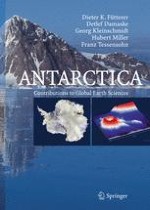2006 | OriginalPaper | Chapter
Scouting Craton’s Edge in Paleo-Pacific Gondwana
Authors : Carol A. Finn, John W. Goodge, Detlef Damaske, C. Mark Fanning
Published in: Antarctica
Publisher: Springer Berlin Heidelberg
Activate our intelligent search to find suitable subject content or patents.
Select sections of text to find matching patents with Artificial Intelligence. powered by
Select sections of text to find additional relevant content using AI-assisted search. powered by
The geology of the ice-covered interior of the East Antarctic shield is completely unknown; inferences about its composition and history are based on extrapolating scant outcrops from the coast inland. Although the shield is clearly composite in nature, a large part of its interior has been represented by a single Precambrian block, termed the Mawson block, that includes the Archean-Mesoproterozoic Gawler and Curnamona cratons of Australia. In Australia, the Mawson block is bounded on the east by Neoproterozoic sedimentary rocks and the superimposed early Paleozoic Delamerian Orogen, marked by curvilinear belts of arc plutons, and on the west by the unexposed Coompana block and Mesoproterozoic Albany-Fraser mobile belt. In Antarctica, these crustal elements are inferred to extend across Wilkes Land and south to the Miller Range region. Aero- and satellite magnetic data provide a means to see through the ice, helping to elucidate the broad composition of the shield. Rocks of the Mawson block in Australia produce distinctive magnetic anomalies; Paleoproterozoic granites and Meso- to Neoproterozoic mafic igneous rocks are associated with high-amplitude, broad-wavelength positive aero- and satellite-magnetic anomalies. The same types of magnetic anomalies can be traced to ice-covered Wilkes Land, Antarctica, and are interpreted to signify similar rocks. However, the diagnostic satellite magnetic high ends ∼800 km south of the Antarctic coast, suggesting that the Mawson block is smaller than first proposed and that the remaining East Antarctic shield is composed of several Precambrian crustal blocks of largely undetermined composition and age. Nonetheless, the coincident eastern borders of these magnetic highs and high seismic-velocity anomalies characteristic of the Precambrian shield, together define the edge of thick cratonic lithosphere. East of this boundary, magnetic lows are explained by magnetite-poor upper Neoproterozoic and lower Paleozoic sedimentary rocks, and their metamorphic equivalents, which crop out discontinuously along the Ross margin of Antarctica and in eastern Australia. These rocks are inferred to overlie a Neoproterozoic rift margin, which transects older basement provinces. The coincidence of this cratonic rift boundary with the western limit of Paleozoic and Jurassic magmatism suggests that, although tectonically modified by younger events, the composite Antarctic-Australian shield comprised thick lithosphere that was not penetrated by Paleozoic and younger convergent-margin magmas.
